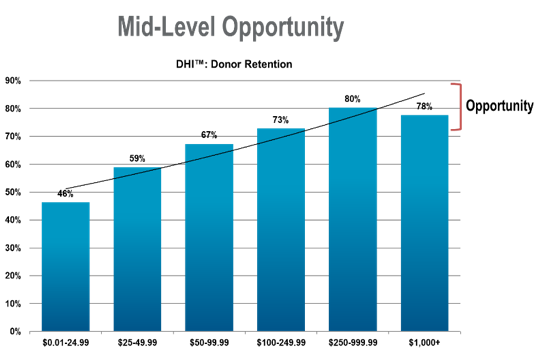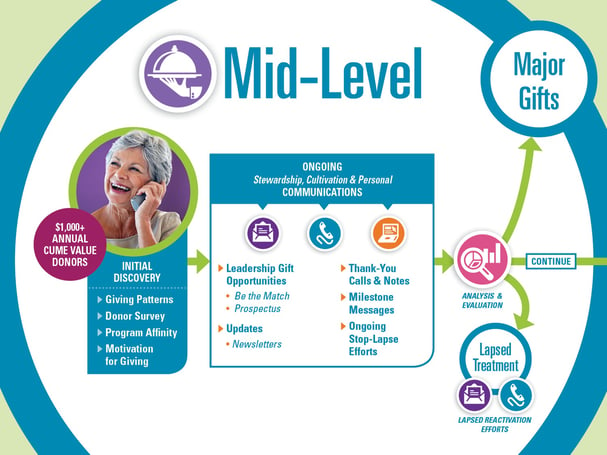
Answers to Your 5 Most Common Mid-Level Donor Questions
It’s hard to believe that at the height of summer, our thoughts have already turned to next year! One of the most exciting elements embedded into TrueSense Marketing’s FY18 programs for our Salvation Army clients is an expanded focus on mid-level donors.
Here are some of the most frequently asked fundraising questions we hear from our Salvation Army friends about our approach to this important group of donors.
Who are mid-level donors?
While many organizations define this group differently, across The Salvation Army, mid-level donors are generally defined as having been active in the last 24 months with a cumulative annual giving level of $1,000–$9,999.
Why are you focusing on $1,000+ donors?
Mid-level donors, while a smaller portion of The Salvation Army donor file, represent a significant opportunity. Mid-level donors historically have some of the highest retention
rates — even small movements in giving behavior can have significant impact on short-term and long-term revenue. Most organizations, including The Salvation Army, see a decline in donor retention once annual giving reaches $1000+.

Several factors contribute to this decline, including the frequency and method of annual donor communication.
What is TrueSense Marketing’s approach to mid-level donors?
Our mid-level donor program is a communication strategy for high-value donors that features upgraded, direct-response appeals that combine increased personalization with focused stewardship efforts and active asks for support. A key element of our approach is assigning 1-2 dedicated members of our Donor Engagement Team (DET) who are trained on all aspects of our clients’ goals, programs, and priorities.
Our approach centers around three phases of activity:
- PHASE 1 (DISCOVERY): Key to our approach is working with the client and major gifts officers to identify pipeline triggers and move qualified donors to development portfolios. Embedded into our approach are milestones to include/exclude donors into/from a major donor prospect pool. We outline program goals and performance metrics, identify donors for mid-level treatment, outline a list of donor actions needed to qualify for a major gift prospect pool, and establish business and data rules as well as our evaluation timelines.
- PHASE 2 (FUNDRAISING PROGRAM DELIVERY): One of our first efforts is a mid-level donor introduction strategy that consists of a letter, phone call, and interest survey to high-value donors. This allows us to establish a relationship with the donor, thank them for their support, and gather feedback about the donor’s interests and communication preferences. It is not uncommon to uncover other points of engagement with a client, including planned gift intentions. Throughout the year, donors receive personalized communications via phone, email, handwritten cards, and reports focusing on their passions. Active appreciation and stewardship efforts are conducted days after a gift has been received. As more donors are included into the mid-level program, we can add additional interest and qualification activities. We also include a proactive reactivation track to ensure donors do not lapse for extended periods of time without a personal invitation to continue their support (or understanding why they chose not to continue their support, and reporting that information back to our clients).

- PHASE 3 (ANALYSIS AND EVALUATION): Our pipeline Donor Health Index® analysis informs decisions about program effectiveness, determines whether changes are required, and helps to evaluate individual donors in the program. Throughout the program year, we conduct periodic reviews to determine program effectiveness, evaluate program performance against stated goals, and evaluate top-value donors for handoff to major gifts.
How is this approach different?
The fact is, many high-value donors are left in a traditional direct-response curriculum for far too long. Through a combination of active cultivation and stewardship, our program connects with these important donors through an integrated, segment-based approach that blends the best of traditional direct response with the high-touch focus of major-gift fundraising. By embedding this approach into a broader communication framework, we can provide agency efficiencies and create a place for high-value donors to migrate in and out, as they may not be appropriate for major-gift pipeline.
How will I know if my mid-level program is successful?
There are three metrics that show mid-level program success: 1) number of donors graduating to major gifts, 2) increased retention rates of mid-level donors, and 3) revenue per active donor.
The benefit of this approach is to provide high-value donors with appropriate treatment that will:
- Improve overall mid-level donor retention rates.
- Boost revenue per donor.
- Increase donor commitment.
- Identify and move appropriate donors into a major giving prospect pool for further cultivation.
- Solidify commitment from donors who are not going to move up, but whose giving merits more engagement/investment.
